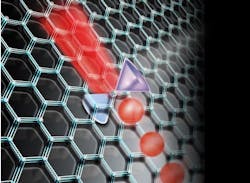New York, NY--The nonlinear behavior of graphene discovered by Columbia Engineering researchers may lead to broad applications in optical interconnects and low-power photonic integrated circuits (PICs). With the placement of a sheet of graphene just one-carbon-atom-thick, the researchers transformed the originally passive device into an active one that generated microwave photonic signals and performed parametric wavelength conversion at telecommunications wavelengths.
"We have been able to demonstrate and explain the strong nonlinear response from graphene, which is the key component in this new hybrid device," says Tingyi Gu, the study's lead author and a PhD candidate in electrical engineering. "Showing the power-efficiency of this graphene-silicon hybrid photonic chip is an important step forward in building all-optical processing elements that are essential to faster, more efficient, modern telecommunications. And it was really exciting to explore the 'magic' of graphene’s amazingly conductive properties and see how graphene can boost optical nonlinearity, a property required for the digital on/off two-state switching and memory."
The study, led by Chee Wei Wong, professor of mechanical engineering, director of the Center for Integrated Science and Engineering, and Solid-State Science and Engineering, was published in the Advance Online Publication Nature Photonics July 15 and in print in the August issue. The team of researchers from Columbia Engineering and the Institute of Microelectronics in Singapore are working together to investigate optical physics, material science, and device physics to develop next-generation optoelectronic elements.
They have engineered a graphene-silicon device whose optical nonlinearity enables the system parameters (such as transmittance and wavelength conversion) to change with the input power level. The researchers also were able to observe that, by optically driving the electronic and thermal response in the silicon chip, they could generate a radio frequency carrier on top of the transmitted laser beam and control its modulation with the laser intensity and color. Using different optical frequencies to tune the radio frequency, they found that the graphene-silicon hybrid chip achieved radio frequency generation with a resonant quality factor more than 50 times lower than what other scientists have achieved in silicon.
"We are excited to have observed four-wave mixing in these graphene-silicon photonic crystal nanocavities," says Wong. "We generated new optical frequencies through nonlinear mixing of two electromagnetic fields at low operating energies, allowing reduced energy per information bit. This allows the hybrid silicon structure to serve as a platform for all-optical data processing with a compact footprint in dense photonic circuits."
Commenting on the study, Xiang Zhang, director of the National Science Foundation Nanoscale Science and Engineering Center at the University of California at Berkeley, says, "this new study in integrating graphene with silicon photonic crystals is very exciting. Using the large nonlinear response of graphene in silicon photonics demonstrated in this work will be a promising approach for ultra-low power on-chip optical communications."
This research is supported by the Columbia Energy Frontier Research Center program, which is funded by the U.S. Department of Energy, Office of Science, Office of Basic Energy Sciences, and the Columbia Optics and Quantum Electronics IGERT (Integrative Graduate Education and Research Traineeship) program, which is funded by the National Science Foundation.
SOURCE: Columbia Engineering; http://engineering.columbia.edu/researchers-pioneer-ultralow-power-optical-information-processing

